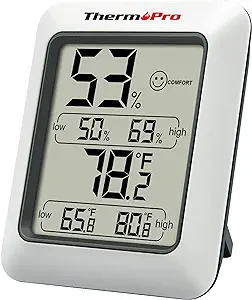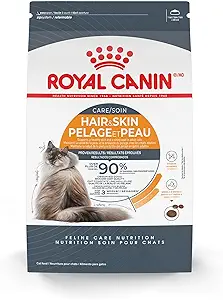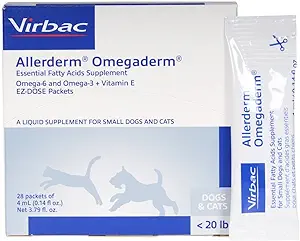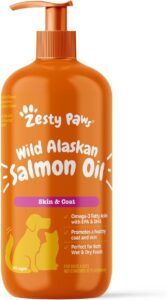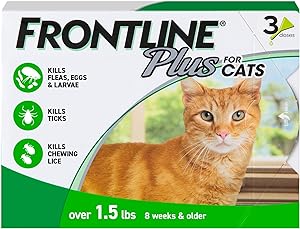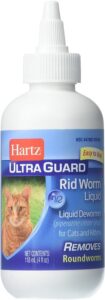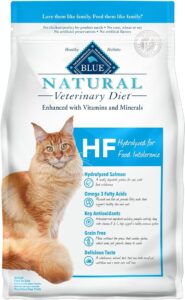What causes dandruff on your cat's chest?
Healthy skin has some cells on the outer layer that are actually no longer alive. But together they still provide good protection of the deeper layers of the skin. And therefore also for the rest of your cat’s body. These superficial cells should be shed more or less one by one. You hardly see this process happening. Those cells are too small to see with the naked eye. However, if something does not go well in that process, a lot of those cells will come loose at the same time and will still stick together. At that moment you will see flakes developing on your cat’s chest in the form of dandruff.
Below you see a schematic cross-section of the skin. The stratum corneum is the layer in the skin with dead skin cells, but which still has an important function. When the cells are exfoliated, the skin cells of the stratum corneum are replaced by the skin cells of the stratum granulosum. It is therefore a continuous process of formation of the cells at the bottom of the image, which slowly move further outwards and then flake off cell by cell. Or, in the case of your cat, whole clumps at a time so that you see them as dandruff on your cat’s chest.
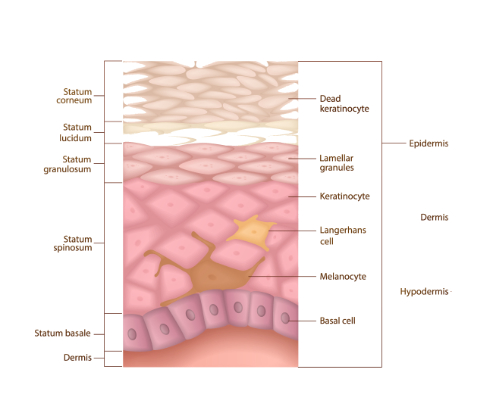
Why does my cat have dandruff on his chest?
There are many possible causes for the appearance of dandruff on your cat’s chest. On this page we limit ourselves to the most common causes and tell you what you can do about them. Do those solutions not help? Please visit your own veterinarian so that he or she can conduct further investigation into the cause of the dandruff on your cat’s chest.
Dandruff on your cat’s chest occurs when the skin is of poorer quality. This can occur because the skin becomes too dry, because there is a shortage of essential fatty acids in his diet, because of parasites or because your cat’s skin is too oily. In that case, the skincells will stick together. It is possible that a very mild food allergy is the cause of your cat’s dandruff on his chest. We discuss the causes one by one below.
Dehydrated skin as the cause of dandruff on your cat's chest
In many households it is cold in wintertime. At that time we often have the heating on so that we are nice and warm. This heating also causes the air in your home to have a low humidity. As a result, moisture evaporates more easily from the skin of your cat. The result is that the skin cells are damaged more easily and therefore start to flake off faster than they should. And they often do this with many cells at the same time, causing dandruff to appear on your cat’s chest. In this case, you mainly see that dandruff on his chest in the colder months of the year and hardly at all in the summer.
The ideal humidity level of the air you live in is between 40 and 60 percent. You can measure this with a hygrometer. By measuring how much moisture there is in the air in your home, you can determine whether this could be the cause of your cat having dandruff on its chest.
If the humidity is too low, you can solve this by ventilating your home more. Open a window slightly or open the ventilation grilles further. If that doesn’t help enough, you can also buy a humidifier.
Deficiency of essential fatty acids
The skin contains fatty acids and these have a very important function. Fatty acids are a bit fat-like and as you may know, fat and water do not find each other very attractive. They try to get away from each other. The skin cells therefore contain many essential fatty acids in their cell walls, so that moisture from the skin cells cannot easily leave those cells. After all, the moisture has to pass through the layer of fatty acids and the moisture would rather not do that. In addition, many essential fatty acids have an anti-inflammatory and cell-healing effect.
So is there a deficiency of essential fatty acids in your cat’s skin? Then the skin can lose moisture more easily (see the part of the dehydrated skin above) and (mild) inflammation in the skin can occur more easily. You will also see a less shiny coat in this case because the fatty acids are also partly used in the production of the hair.
The cheaper the food you provide, the lower the quality of the ingredients. And this is reflected, among other things, in the amount of essential fatty acids in the diet. To solve this, you can either buy a more expensive diet or you can add a nutritional supplement containing essential fatty acids to the current diet your give your cat. Allerderm Omegaderm is one of the best products, but salmon oil is also sufficient in most cases and a lot cheaper.
Parasites in or on the skin
As mentioned earlier, your cat may also have dandruff on his chest if parasites are involved. Fleas are of course a possibility, but they often cause itching rather than dandruff. Mites are a good reason to see dandruff on your cat’s chest. The demodex mite causes more bald spots and less flakes and is therefore less likely. The Sarcoptes mite causes itching and crusty bald spots on the skin and is therefore less likely to occur in this case. But the Cheyletiella mite is a very surface-dwelling mite that is known to cause no symptoms other than a coat full of dandruff. They also call it the walking dandruff mite or fur mite.
Mites are quite persistent spider-like creatures. Unfortunately, regular flea products do not kill them. You can pick up a product against mites at the counter of your vet (Bravecto, Stronghold, Advocate, etc.). But actually that is not necessary at all if your cat only has dandruff and no other symptoms on his chest.
If you want to tackle all possible mites, you will have to do it with the above named products. But the scale mite is one of the mites that is actually not that persistent at all. This mite is killed by the substance Fipronil. And that product is a commonly used product that is found in flea products. This does not kill other mite species, but this scale mite does.
Parasites in the intestines are the cause of dandruff on your cat's chest.
If your cat has a lot of worms in his intestines, those worms can eat the important nutrients. They are then no longer available to your cat. In this case it mainly concerns the essential fatty acids, but of course it applies to all nutrients. So if your cat has not been dewormed for a while, it is wise to do so again. We recommend that you deworm your cat once every 3 months. This is to prevent your cat from becoming completely full of worms. In the 3 months between treatments, a few worms may develop in his intestines. But a few worms are generally not a problem.
Too much sebum production from the skin
When your cat’s skin produces too much sebum, the coat becomes too greasy. You usually also feel a somewhat greasy feeling on your hands after you have stroked your cat vigorously. This is also a sign that your cat’s skin is not functioning in optimal state. The result is exfoliation of the skin cells in a high speed, which then also stick together due to the grease. They also stick to your cat’s fur in the form of dandruff on his chest. This condition is also called Seborrhea and unfortunately cannot be cured. Purebred cats such as the Himalayan cat, the long-haired Persian and the short-haired Persian are especially sensitive to this.
By keeping the coat as short as possible and maintaining the coat well, it is possible for your cat to live with this. You can reduce the excessive amount of sebum with Douxo S3 Seb mousse. This makes the skin itself considerably stronger. This will significantly reduce the amount of flakes on your cat’s chest. You must of course continue to use this regularly. After all, the condition can not be cured.
A food allergy is the cause of dandruff on your cat's chest
In general, a food allergy mainly causes itching or gastrointestinal complaints for your cat. But in very mild cases, your cat may just develop an excessive amount of dandruff on his chest. This is because the quality of the skinis poor as a result of the food allergy. Did the above named treatments didn’t give relieve of the dandruff? Then you can give your cat a food to which he cannot have an allergic reaction. This is because the ingredients are made so small that they do not fit your cat’s immune system. Therefore, no allergic reaction can occur.
If you want to test this, only give your cat the following kibble from the moment the test starts. No sweets or things from your refrigerator. Because your cat can also be allergic to that. During the first 4 weeks you probably won’t see any changes because the old ingredients still have to disappear from your cat’s body. Only after 4 weeks will you see that the amount of dandruff decreases. Do you see no difference after 8 weeks? Then there is no point in continuing with this. Although you can give the food to your cat for life, there will not be a sudden change in the dandruff on your cat’s chest after 8 weeks. In this case it was not caused by a food allergy.
Good luck
We wish you have found some helpful ideas you can try to get rid of the dandruff on the chest of your cat. Hopefully your cat wil have a clean and shiny coat soon! Good luck!

